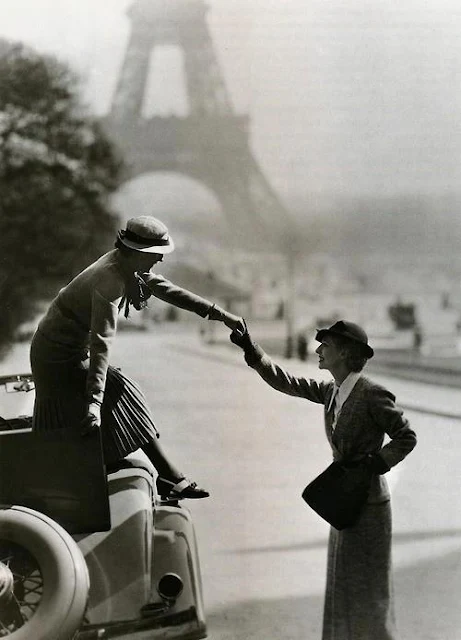George Hoyningen-Huene (1900–1968), a pioneer of 20th-century fashion photography, is celebrated for his mastery of light, composition, and elegance. Known for his work with major fashion magazines like Vogue and Harper's Bazaar, Hoyningen-Huene transformed fashion photography into a sophisticated art form. With a unique eye for detail and a penchant for blending classical art with modern aesthetics, his legacy remains a cornerstone in the history of photography.
A Noble Background and an Artistic Evolution
Born into Russian aristocracy in St. Petersburg, Hoyningen-Huene fled Russia during the 1917 revolution, settling in Paris. His early experiences shaped his artistic sensibilities, as he immersed himself in the bohemian circles of Paris during the 1920s. Initially working as an illustrator and costume designer, he transitioned to photography when he joined French Vogue as a studio assistant in 1925.
Hoyningen-Huene quickly rose through the ranks, becoming the magazine’s chief photographer in 1928. His refined aesthetic, influenced by classical art and avant-garde trends, distinguished his work from his contemporaries.
Key Themes in Hoyningen-Huene's Photography
Classical Elegance and Timeless Beauty
Hoyningen-Huene's photography is characterized by a profound connection to classical art. Drawing inspiration from Greek and Roman sculptures, Renaissance paintings, and the work of Old Masters, he infused his photographs with a sense of timeless beauty.
In one of his most iconic images, Divers, Paris (1930), Hoyningen-Huene depicts two swimmers sitting by a pool, their bodies positioned with a sculptural precision reminiscent of classical friezes. The interplay of light and shadow highlights their form, emphasizing the harmony of human anatomy and geometry.
The Dance of Light and Shadow
Hoyningen-Huene’s work demonstrates an unparalleled understanding of light. He often used dramatic chiaroscuro effects to create depth and mood, drawing comparisons to the works of Caravaggio and Rembrandt.
For instance, his photograph Horst in Corset (1939) showcases his ability to sculpt the human form using light. The interplay of highlights and shadows creates an ethereal quality, elevating the image beyond a mere fashion shot into the realm of fine art.
Fashion as Art
At a time when fashion photography was still emerging as a genre, Hoyningen-Huene elevated it to an art form. He viewed clothing as more than mere fabric, capturing the artistry and craftsmanship of couture in every frame. His ability to combine aesthetic elegance with commercial appeal made him a favorite among designers and editors alike.
His collaborations with designers like Coco Chanel and Elsa Schiaparelli resulted in iconic images that celebrated the avant-garde spirit of 1930s fashion.
Hoyningen-Huene’s Unique Style
Hoyningen-Huene’s style is a blend of modernism and classicism. His photographs are meticulously composed, with each element—pose, lighting, backdrop—carefully orchestrated to create visual harmony.
He often used minimalistic sets, focusing on the subject and their attire. This approach emphasized form and structure, drawing attention to the intricate details of the clothing and the expressive poses of his models.
 |
| George Hoyningen-Huene. Vogue -1930 |
The Human Element in Hoyningen-Huene’s Work
Despite his focus on elegance and aesthetics, Hoyningen-Huene’s work never felt detached or cold. His portraits, whether of fashion models or celebrities, exude warmth and intimacy.
One notable example is his portrait of Katharine Hepburn (1935), which captures the actress's strength and grace. The soft lighting and subtle pose highlight her individuality, showcasing Hoyningen-Huene's ability to reveal the essence of his subjects.
 |
| Katharine Hepburn. George Hoyningen-Huene |
The actress Katharine Hepburn, casual with a white t-shirt and a blade of grass on the lips (1934).
Impact and Legacy
Hoyningen-Huene’s influence extends far beyond his own era. His techniques and aesthetic principles paved the way for future photographers like Irving Penn and Richard Avedon, who drew inspiration from his meticulous approach to composition and lighting.
His works are now celebrated in major exhibitions and collections worldwide, including the Museum of Modern Art in New York and the Victoria and Albert Museum in London.
Selected Works and Their Significance
1. Divers, Paris (1930)
This photograph remains one of Hoyningen-Huene’s most famous works. The minimalist composition, combined with the sculptural poses of the swimmers, exemplifies his classical approach to photography.
 |
| by George Hoyningen-Huene. 1929 |
Another immortal: in this 1929 appears to be a model about to jump out, wearing a swimsuit dot with belt, designed by Jean Patou. A snapshot that then would recreate Jerry Hall for the lens of Norman Parkinson in 1975. With a swimsuit and red hat to the game, the model posed in a session that summed up the first trip of Vogue to the Soviet Union in the Cold War.
2. Horst in Corset (1939)
This image, featuring his protégé Horst P. Horst, highlights Hoyningen-Huene’s ability to transform a simple fashion shoot into a study of form and light.
3. Portraits of Katharine Hepburn (1935)
These portraits capture the actress at the height of her career, blending Hollywood glamour with Hoyningen-Huene’s refined aesthetic.
Hoyningen-Huene in the Context of Modern Photography
In an era dominated by digital manipulation and high-speed production, Hoyningen-Huene’s meticulous approach offers valuable lessons. His commitment to artistry, attention to detail, and understanding of light remind us of the enduring power of craftsmanship in photography.
Modern photographers continue to study his work, drawing inspiration from his timeless compositions and innovative techniques.
 |
| Salvador Dali. by George Hoyningen-Huene |
Conclusion: Rediscovering Hoyningen-Huene’s Genius
George Hoyningen-Huene was more than a fashion photographer; he was a visionary who transformed photography into a medium of artistic expression. His work continues to inspire, reminding us of the beauty that lies in simplicity, precision, and a deep understanding of light.
As the art world revisits his legacy, Hoyningen-Huene’s genius shines brighter than ever, solidifying his place among the greats of photography history.




